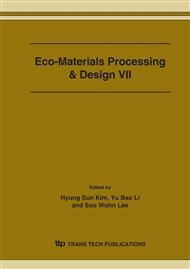p.102
p.106
p.110
p.114
p.118
p.122
p.126
p.130
p.134
Characterization of Li1-xNi1+xO2 Prepared by Using Tartaric Acid as a Complexing Agent
Abstract:
Li1-xNi1+xO2 powder was prepared by using tartaric acid as a complexing agent. A 1 : 1 : 2 mole ratio of Li : Ni : tartaric acid was used to form carboxylate precursors which were calcined at 650–800 oC for 14–48 h. TGA of the precursors showed that formation of Li1-xNi1+xO2 initiates at 600 oC and above. By using XRD, Li1-xNi1+xO2 with 650–800 oC calcination was detected. Calculated intensity ratios of I(003)/I(104) and I(006+102)/I(101) showed that the best condition is at 750 oC for 34 h. The crystallite size was estimated using the Scherrer equation. AAS and titration techniques showed that Ni3+/(Ni3+ + Ni2+) and mean oxidation state of nickel are 66.50 wt% and 2.67 respectively. EDX showed that the powder was comprised by Ni and O. The faceted particles are shown by SEM. TEM and electron diffraction showed the results that are in accordance with the above.
Info:
Periodical:
Pages:
118-121
Citation:
Online since:
March 2006
Authors:
Keywords:
Price:
Сopyright:
© 2006 Trans Tech Publications Ltd. All Rights Reserved
Share:
Citation:


